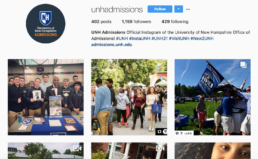Are you using social media to recruit college students to your institution?
Or, better yet: Are you effectively using social media for recruitment?
Universities and marketing professionals for decades have been using the same tried and true methods to communicate with potential students. However, as the digital and mobile worlds continue to advance, the way those students research and decide on a university changes, so your higher education marketing strategy needs to change, as well.
Sure, direct mail, commercials, counselor recommendations, and college visits are critical components of college admissions, but as prospective students turn to Instagram, Snapchat, and Facebook to aid in their decision-making process, more and more schools are adjusting their recruitment strategies to reflect student behavior.
When prospective students research colleges these days, they’re looking for a reputable program that fits their interests, a knowledgeable faculty, and a campus size and layout that they’ll feel comfortable with. But more importantly, they’re looking for a place they can feel passionate about and call home during their collegiate career. Today’s generation of students is doing research on their own terms, and they’re now able to get a 24/7 look into the school’s campus life using the power of social media.
Social media for college admissions is a powerful tool, so long as you harness that power effectively. As universities across the country deal with declining application rates, increased competition from other schools and online programs, and a more tech-savvy student, it’s time for college admissions to get creative. The following tips will help you in developing a smart social media strategy to both recruit and engage new students and keep your university on the digital map.
Your university most likely has a social media marketing plan in place with accounts already set up on the major social networks where students are spending their time. However, when using social media to recruit, it’s critical to establish dedicated accounts for the admissions office to manage. This not only gives students a specific place to send their questions and find the information they need, but it helps the university create content geared towards potential or incoming students.
So, what social networks should you create admissions accounts for? With so many “shiny new objects” to play with, try to focus in on the platforms where prospective students are spending most of their time, that also have the most potential for accomplishing the goals of the admissions office. For example, LinkedIn and Pinterest may not be your best bet at this stage of the student journey, but Instagram and Snapchat could be great fits. The latter platforms are more visual, real-time, personal, and engaging, and can be used to portray your campus culture and raise awareness around upcoming dates and events. Not to mention, Instagram and Snapchat are dominating the attention of 16-20 year olds.

The University of New Hampshire does an awesome job of using social media to connect and engage with potential students. They’re using dedicated Instagram and Twitter accounts with clear @UNHadmissions handles to showcase videos of campus hotspots and share infographics & checklists to help new students transition smoothly onto campus, and they’ve established a unique hashtag ‘#New2UNH’ to tie all of their content and student posts together. If you take a second to look through the #New2UNH images, you’ll see the university is tying the campaign together with physical banners with the school logo that read “I’m in! #New2UNH” that students post from their own accounts using the hashtag.
We see Snapchat as one of the biggest social media opportunities for colleges to take advantage of because of its user base, the attention it demands, and its creative features. UNH uses an @UofNHaccount for more top-down snaps, but the real magic happens on their @UNHstudents account. They’ll have students run “account takeovers” and share content captured around campus – this gives current students a way to engage with each other and see what’s happening on their campus, but it’s also helpful for potential students. A campus tour is great for learning the lay of the land and seeing where you’d be attending classes, but Snapchat let’s new students see what life is like on campus 365 days a year, all from their smartphone.
#ProTip: Snapchat is simple in its functionality, but it gives users some wiggle room in terms of creativity. The Snapchat Story feature allows you to create a continuous “story” of either images or short video clips that remain visible to followers for 24 hours. Creating stories with meaning and context versus incohesive ‘snaps’ truly allows you to get a message across in a way that’s native to how students are already using the app. Think of these as mini visual blog posts. Some example stories to get you going could be “5 Best Spots to Eat Lunch on Campus”, or “10 Things Freshmen Should Know About [your school]”. Notice these topics bring value to current students, and also help prospective students learn about campus life and culture.
Now that you know where you’ll be focusing your effort, it’s time to understand how prospective students are using social media to decide which college to attend.
Ready for this one? People under the age of 25 use Snapchat for an average of 40 minutes every single day! And you guessed it – that number’s going up. You may have the impression that the app is for the young crowd and mostly used to share things you don’t want your grandma seeing in her Facebook newsfeed, and that may be true. However, Snapchat is scaling upwards in age and with widespread acceptance among college crowds, it’s quickly finding its place in the higher education marketer’s toolbox.
Since social media is breaking the mold for how potential students research and decide on a college; higher education programs need to adjust how they target and interact with them. Social media is nonstop, and your strategies should be, too. College admissions offices need to be equipped to produce content, listen, and engage with students year-round. It’ll likely be a turnoff if a student is checking out your Instagram admissions account and sees there hasn’t been any activity in weeks…
Not only are colleges trying to recruit students, but students are recruiting each other by documenting their college search experience. Students visiting colleges and taking campus tours will be creating stories on Snapchat, posting campus pictures on Instagram, and broadcasting live on Facebook. Without the proper strategies and social media monitoring and engagement tools like Hootsuite or Tweetdeck, admission offices could be missing out on opportunities to capitalize on already positive experiences, or help to flip poor ones.
When it comes time to admit or deny college applicants, try thinking outside the box when approving new students. In the Fall of 2016, the University of Wisconsin gave applying students the option to receive their acceptance letter via Snapchat. Pretty unconventional, right?! They still mailed out real acceptance letters, but that’s a super cool way to interact with new students and create an experience worth sharing.
#ProTip: Create a unique hashtag to tie school content and student generated content together in one place. Hashtag use is really geared towards Instagram and Twitter, but it makes it easier to listen and engage with students. It doesn’t mean you have to leave a comment on every post… but a quick ‘double-tap’ on Instagram or ‘heart’ on Twitter shows them you’re listening. Your college might be doing this already, but your admissions department should be, too.
Students interested in attending your university want to know what it’s really like to be a part of campus life. The most cost-effective way of translating campus life to social media is by using student-generated content. With thousands of students already creating shareable content from around campus, universities can share those experiences with incoming students to give the truest portrayal of college life.

A massive shift towards mobile coupled with social media platforms focused on video gives college programs the ability to present their campus in motion. During the 2016-2017 school year, video was just starting to roll out across platforms. Instagram still had 15-second video limits, and Facebook hadn’t yet rolled out its Facebook Live broadcasting. The 2017-2018 school year will give universities their first opportunity to bring pictures to life with extremely low barriers to entry. Forget production sets or fancy cameras. Whip out a smartphone and instantly share video with your audiences. Remember to put yourself in the shoes of a 17-year-old who’s interested in attending your school: a Facebook Live video of the homecoming football game makes a bigger impression than a static image of the game. Prospective students are using these features; your school should, too.
Most universities have an active blog, which is an important tool for driving traffic to your website and boosting SEO ranking, but it can also act as a central hub for all of your content to live. Try to keep the blog light and human; it’s a great opportunity to engage with current students, but it also serves as a recruitment tool for students and parents. Most university blogs, just like UNH’s ‘UNHTales’ blog, let students take the reigns and provide an authentic voice on campus life. Keeping content centralized on a blog also empowers your social media team to easily direct people to the links they’re looking for.
#ProTip: Don’t neglect the parents! Moms and dads love being “in the know” about life on campus and being able to visualize where their children will be living for the next however many years. Be sure to create blog content and present information in a way that speaks to this crowd. Not to mention they often hold some serious weight in the decision-making process.
Your social media marketing strategy for student recruitment needs to be a living, breathing strategy that adjusts and develops with platform updates and changes in student behavior. Lay the foundation for success by empowering your admissions team to manage their own accounts, understand how students are researching and sharing college search experiences, and create timely and relevant information that matters to them to keep your university at the top of their consideration set.
If you found value in this blog post, we think you’ll also like our monthly education marketing newsletter. They’re packed with value and will help keep you up to date with how the latest social media trends impact digital strategy for EdTech and Higher Education organizations.
Does your social media marketing strategy need a little guidance? We’re helping organizations transform their digital marketing efforts through personalized 2 hour, 1-on-1 trainings. These trainings include:
- Audit of your Facebook, Instagram, & Snapchat accounts
- Maximizing your social media marketing organically
- Customized strategy for running ads that convert
- Copies of presentation & notes to review on your own
- Actionable tips to start winning on social media
Learn more through the button below and see if it’s the right fit for you & your team!


